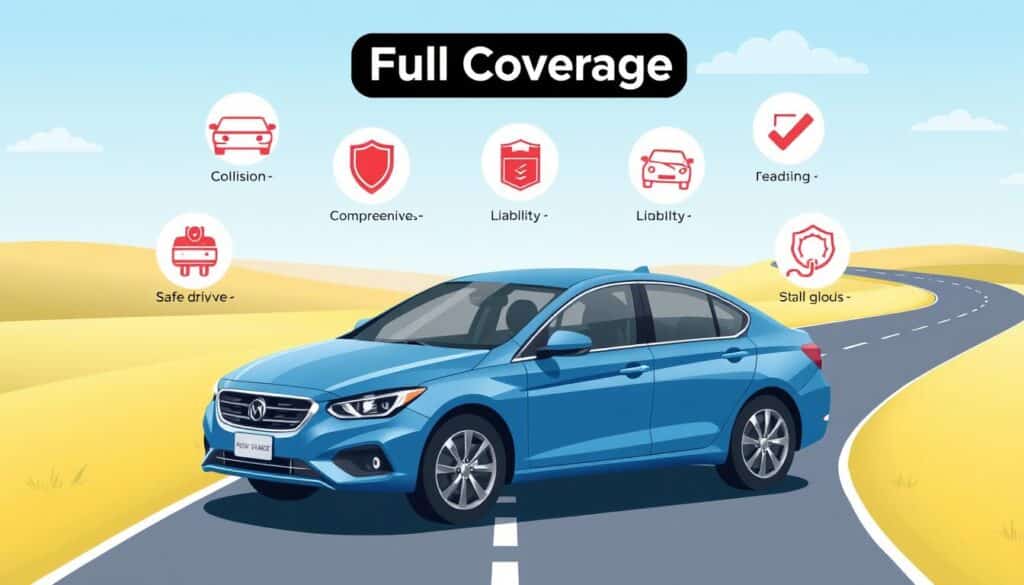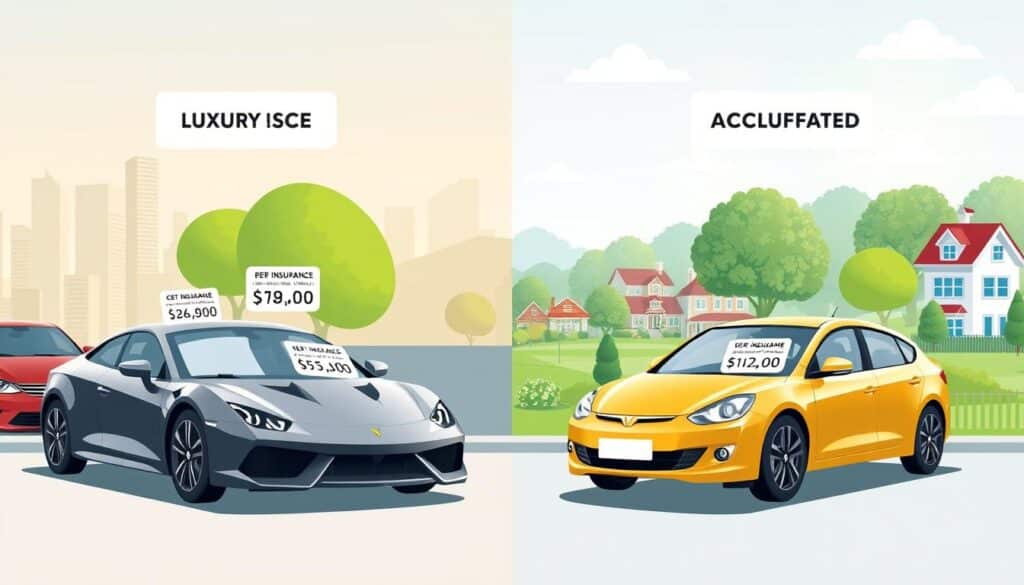Drivers in the United States are looking closely at their auto insurance costs. The latest Annual Report from Bankrate shows the average cost of full coverage car insurance is now $2,543 in 2024. This is a 26% jump from last year. With the median household income at $74,580, Americans spend about 3.41% of their income on car insurance.
This report dives deep into the cost of auto insurance in the U.S. It highlights what affects full coverage premiums. It also helps find the most affordable options.

Key Takeaways
- The national average cost for full coverage car insurance in 2024 is $2,543 per year, or $212 per month.
- Drivers with minimum coverage pay an average of $740 a year, or $62 a month.
- Drivers in Louisiana have the highest average annual premium for car insurance at $3,618, which accounts for 6.53% of their household income.
- Full coverage insurance can be more than three times the price of minimum-required liability insurance.
- The average cost of full coverage auto insurance varies significantly by age, with 20-year-old drivers paying a median rate of $3,672 per year, while 60-year-old drivers pay $1,557 annually.
Understanding the True Cost of Auto Insurance
The cost of auto insurance is more than just the monthly premium. The average full coverage car insurance policy costs $2,014 per year. This is about 2.93% of the median household income of $68,852. However, this percentage has gone up from 2.57% in 2022, making it harder for many drivers to afford.
The cost of auto insurance varies a lot across the United States. In states like New York, drivers spend over 5% of their annual income on car insurance. On the other hand, Maine residents pay just over 1% of their income for the same coverage. These differences are due to many factors, including state laws and the local cost of living.
Nationwide Average Premiums and Income Percentages
Looking beyond national averages is key to understanding the true cost of auto insurance. Car insurance rates can vary a lot from state to state. For example, drivers in Wyoming pay around $970 for full coverage, while those in Louisiana pay $3,115. The average annual cost of a full coverage policy also varies, with Allstate charging $2,333 and USAA charging $1,174.
| State | Full Coverage Median Rate | Percentage of Income Spent on Car Insurance |
|---|---|---|
| Wyoming | $970 | 1.41% |
| Vermont | $1,100 | 1.59% |
| New Hampshire | $1,110 | 1.61% |
| Louisiana | $3,115 | 6.53% |
| Florida | $2,746 | 5.69% |
| Texas | $2,516 | 4.43% |
Life events can also affect the cost of auto insurance
www.nerdwallet.com
Average Cost of Car Insurance – NerdWallet. Things like a lower credit score, a speeding ticket, or a DUI conviction can increase your premiums a lot.
It’s important for drivers to understand the true cost of auto insurance. By looking at regional differences, personal situations, and how much of your income goes to insurance, you can make better choices.
“The true cost of auto insurance is more than just the monthly premium – it’s about understanding how much of your income is going towards that coverage.”
Key Factors Impacting Full Coverage Auto Insurance Costs
Several key factors can greatly affect the cost of full coverage auto insurance. Your driving history is very important. Drivers with clean records usually pay less than those with accidents or tickets. Also, where you live matters a lot. City drivers often pay more because of more thefts and accidents.
Your age and gender also play a part. Older drivers tend to have fewer accidents, which means lower premiums. Women generally have fewer accidents and DUIs than men, leading to lower insurance costs for them.
The type of car you drive is another big factor. The car’s cost, theft risk, repair costs, engine size, and safety features all affect your premiums. Your credit score is also important. Insurers use it to guess the cost of future claims. Lower scores mean higher rates.
Lastly, the coverage levels you choose impact your costs. Things like the deductible and policy options matter. Luckily, there are discounts like good driver and student discounts. These can help lower the cost of full coverage auto insurance.
Knowing these factors can help you find the best full coverage auto insurance policy. By understanding your situation and using discounts, you can get the right coverage without breaking the bank.
full coverage auto insurance: What It Covers
“Full coverage” auto insurance offers more than just the basic liability coverage needed by most states. Liability insurance is a must in nearly every state. It covers damages or injuries to others, up to a certain limit. But full coverage also includes comprehensive and collision coverage, plus any other state-mandated coverages.
Comprehensive coverage helps pay for repairs or replacement if your car is damaged by theft, vandalism, fire, hitting an animal, or weather damage. This is minus the deductible. Collision coverage, on the other hand, covers repairs or replacement if your car hits something, minus the deductible, no matter who’s at fault.
Full coverage auto insurance may also include uninsured/underinsured motorist coverage. This protects you if you’re hit by a driver with little or no insurance. Personal and advertising injury liability and products-completed operations coverage might also be included. These provide protection against various liability risks.
While a policy with just liability coverage costs less, a full coverage policy can be over $4000 a year, according to Wallethub. If your insurance premium is more than 10% of your car’s value, you might want to consider a Liability-only policy.
Finding the right full coverage auto insurance plan is about your needs, your car’s value, and your budget. Knowing what full coverage includes helps you choose the right protection for your driving and financial situation.

| Coverage Type | Description | Benefits |
|---|---|---|
| Liability Coverage | Covers damages or injuries caused to another vehicle or person, up to a specified limit. | Protects you from financial responsibility if you cause an accident. |
| Comprehensive Coverage | Pays for repair or replacement of a vehicle in case of events like theft, vandalism, fire, hitting an animal, or weather-related damage. | Covers a wide range of non-collision related damages to your vehicle. |
| Collision Coverage | Pays for repairs or replacement of a vehicle in case of a collision with another car, motorcycle, obstacle, or object, regardless of fault. | Helps cover the cost of repairing or replacing your vehicle after a collision. |
| Uninsured/Underinsured Motorist Coverage | Protects you if you’re involved in an accident with a driver who has insufficient or no insurance. | Provides financial protection if the at-fault driver does not have adequate coverage. |
Remember, the specific coverage details and costs of a full coverage auto insurance policy can vary based on factors such as your location, driving history, vehicle details, coverage limits, and deductibles.
“Having ‘full coverage’ protects against a wide range of financial risks and can give you peace of mind on the road.”
Advertisement
Finding the Cheapest Full Coverage Car Insurance
Finding the cheapest full coverage car insurance can be tough. But, with the right steps, drivers in the U.S. can save a lot. The Bankrate report shows Geico offers the lowest median annual rate at $1,296, followed by American Family at $1,324 and Travelers at $1,386. To get the best deal, it’s key to compare quotes from many insurers, including smaller ones.
Shopping around and comparing rates can lead to big savings. This is especially true for drivers with accidents, DUIs, or poor credit. By comparing different scenarios, you can find the cheapest insurance that fits your needs.
Comparing Rates Across Major Insurers
It’s crucial to compare rates from top insurance providers to find the cheapest full coverage car insurance. NerdWallet’s October 2024 analysis found Travelers offers the cheapest full coverage auto insurance in Florida, with an average annual rate of $1,859. The average annual cost of full coverage car insurance in Florida is $3,104, equivalent to $259 monthly. Choosing minimum coverage can save you money, with an annual cost of $798 or $67 per month.
| Insurance Provider | Average Annual Cost of Full Coverage | Average Annual Cost of Minimum Coverage |
|---|---|---|
| Travelers | $1,859 | $798 |
| State Farm | $2,419 | $842 |
| Geico | $2,589 | $781 |
| Florida Average | $3,104 | $798 |
Understanding auto insurance rates from major providers can help. Exploring options beyond the top national insurers can lead to finding the most affordable full coverage car insurance that fits your budget.

Conclusion
In conclusion, understanding full coverage auto insurance in 2024 is key. The national average cost is now $1,730 per year. It’s crucial to compare quotes to find affordable coverage that fits your needs.
Consider your driving history, credit score, vehicle, and where you live. Also, look for discounts to get the best value for your policy. USAA, Erie Insurance, and Nationwide offer the cheapest rates. State Farm and Travelers also have good rates and customer satisfaction.
Choosing full coverage auto insurance should be a thoughtful decision. Know the different coverage types like liability and comprehensive. This way, you can choose the right protection that’s also affordable.
FAQ
What is the average cost of full coverage auto insurance in the United States?
The latest Annual Report from Bankrate shows a big jump. The average cost of full coverage car insurance is now $2,543 in 2024. This is a 26% increase from the year before.
What percentage of household income do Americans spend on car insurance?
With a median household income of $74,580, Americans now spend 3.41% of their income on car insurance. This is a significant amount.
How do full coverage auto insurance costs vary across different states?
Costs vary a lot by state. In Louisiana, Florida, and Michigan, drivers spend 6.53%, 5.69%, and 5.01% of their income on car insurance, respectively. But in Massachusetts, drivers only spend 1.76% of their income on full coverage.
What factors can significantly impact the cost of full coverage car insurance?
Several factors can affect the cost of full coverage car insurance. These include your driving record, credit score, age, gender, vehicle type, location, and chosen coverage levels.
What types of coverage are included in a full coverage auto insurance policy?
Full coverage auto insurance includes several types of coverage. Liability coverage protects you from financial responsibility if you cause an accident. Comprehensive and collision coverage pay for damage to your vehicle, no matter who’s at fault.
Which insurance companies offer the cheapest full coverage car insurance?
Geico offers the cheapest full coverage car insurance at $1,296 per year. American Family and Travelers follow at $1,324 and $1,386, respectively. Shopping around can help you find even better deals.

